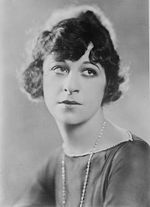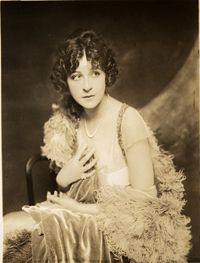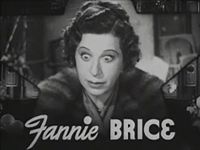Fanny Brice
| Fanny Brice | |
 | |
| Birth name: | Fania Borach |
|---|---|
| Date of birth: | October 29 1891 |
| Date of death: | May 29 1951 (aged 59) |
| Death location: | Hollywood, Los Angeles, California, USA |
| Spouse: | Frank White Julius "Nicky" Arnstein Billy Rose |
Fanny Brice (October 29, 1891 – May 29, 1951) was a popular and influential American comedienne and singer who starred in theatre, radio, and film. She was the creator and star of the top-rated radio comedy series, The Baby Snooks Show that ran from 1936 to 1951.
In an era when ethnic comedy was the norm Brice delighted audiences with her Yiddish accent and satirical characters for more than forty years and won a following in almost every branch of American show business.[1]
In 1909 she scored her first success singing an Irving Berlin song Sadie Salome, Go Home in the musical The College Girls. Brice’s infectious comedy style and vocals made her the featured performer of nearly all the Ziegfeld Follies from 1910 through 1923. Alongside such top-billed performers as W. C. Fields, Raymond Hitchcock, Van & Schenk and Ted Lewis.
With arrival of talking pictures, Brice went to Hollywood and starred in My Man (1928), and Be Yourself (1930). Brice became the first woman to star in a sound motion picture, but both films were failures and Brice soon returned to Broadway.[1]
In addition to her Broadway and radio success, Brice also had top ten hits with My Man (#1 in 1992), Second Hand Rose (#3, 1922), I’m an Indian (#9, 1922) and I’d Rather Be Blue Over You (Than Be Happy With Somebody Else) (1929).
Barbra Streisand starred as Brice in the 1964 Broadway musical Funny Girl, and in 1968, Streisand won the Academy Award for Best Actress for reprising her role in the film version.
Early life
Fanny Brice (occasionally spelled Fannie) was the stage name of Fania Borach, born in New York City, the third child of relatively well-off saloon owners of Hungarian Jewish descent. Her mother, Rose Stern, left a small village near Budapest to come to America in 1877. Charles Borach, her father, set off from Alsace, France during the late 1870s or early 1880s. When they met in [Manhattan]], Rose was working at a sewing machine in a fur factory and Charles was a bartender in a Bowery saloon.
They married in 1886 and at the time of Fanny's birth, they were living on Forsyth Street. By 1895, they had left the Lower East Side's congestion and crime for Newark, New Jersey.
Borach's gambling caused his wife to leave him, taking her children to Brooklyn (c. 1902). Charles Borach followed them to New York and drifted into a series of odd jobs. When he died in 1912, he had lost virtually all contact with his family. Brice, who accepted the estrangement from her father as irrevocable, would mirror her mother's lack of marital success in her own life.
A chronic truant who ended her formal education around the eighth grade she found success in neighborhood amateur night contests, beginning with a victory in 1906 at Keeney's Theatre, Brooklyn's leading vaudeville theater.[1]
Follies and films
Two years after her start in a burlesque revue she began her association with Florenz Ziegfeld, headlining his Ziegfeld Follies from 1910 into the 1930s.
In the 1921 Follies, she was featured singing "My Man" which became both a big hit and her signature song. She made a popular recording of it for Victor Records. The second song most associated with her is Second Hand Rose. She recorded nearly two dozen record sides for Victor and also cut several for Columbia Records.
Her films include My Man (1928), Be Yourself! (1930) and Everybody Sing (1938) with Judy Garland. Brice, Ray Bolger and Harriet Hoctor were the only original Ziegfeld performers to portray themselves in The Great Ziegfeld (1936) and Ziegfeld Follies (1946).
Career
From the 1930s until her death in 1951, Fanny made a radio presence as a bratty toddler named Snooks, a role she first premiered in a Follies skit. With first Alan Reed and then Hanley Stafford as her bedeviled Daddy, Baby Snooks premiered in The Ziegfeld Follies of the Air in February 1936 on CBS. She moved to NBC in December 1937, performing the Snooks routines as part of the Good News show, then back to CBS on Maxwell House Time, the half-hour divided between the Snooks sketches and comedian Frank Morgan, in September 1944. She was back to NBC in November 1948, in a full show of her own, first called Toasties Time but soon known as The Baby Snooks Show.
Brice was so meticulous about the program and the title character that she was known to perform in costume as a toddler girl even though seen only by the radio studio audience. She was 45 years old when the character began her long radio life. In addition to Reed and Stafford, her co-stars included Lulu Roman, Lalive Brownell, Lois Corbet and Arlene Harris playing her mother, Danny Thomas as Jerry, Charlie Cantor as Uncle Louie and Ken Christy as Mr. Weemish. She was completely devoted to the character, as she told biographer Norman Katkov: "Snooks is just the kid I used to be. She's my kind of youngster, the type I like. She has imagination. She's eager. She's alive. With all her deviltry, she is still a good kid, never vicious or mean. I love Snooks, and when I play her I do it as seriously as if she were real. I am Snooks. For 20 minutes or so, Fanny Brice ceases to exist."
Baby Snooks writer Everett Freeman told Katkov that Brice didn't like to rehearse the role but always snapped into it on the air, losing herself completely in the character: "While she was on the air she was Baby Snooks. And after the show, for an hour after the show, she was still Baby Snooks. The Snooks voice disappeared, of course, but the Snooks temperament, thinking, actions were all there."
Brice and Stafford brought Baby Snooks and Daddy to television only once, an appearance in 1950 on CBS-TV's Popsicle Parade of Stars. This was Fanny Brice's only appearance on television. Viewing the kinescope recording today, Fanny is a strange, but amusing sight: a middle-aged woman in a little girl's outfit (and none of the other cast seem to find this unusual). Brice handled herself well on the live TV broadcast but later admitted that the character of Baby Snooks just didn’t work properly when seen. She returned with Stafford and the Snooks character to the safety of radio for her next appearance, on Tallulah Bankhead's legendary big-budget, large-scale radio variety show, The Big Show, in November 1950, sharing the bill with Groucho Marx and Jane Powell. In one routine Snooks knocks on Bankhead's dressing room door for advice on becoming an actress when she grew up in spite of Daddy's warning that she already lacked what it took.
Six months after her Big Show appearance, Fanny Brice died in Hollywood at the age of 59 of a cerebral hemorrhage.
Marriages
Brice had a short-lived marriage in her teens to a local barber, Frank White. Her second husband was professional gambler Julius "Nicky" Arnstein. Prior to their marriage, Arnstein served 14 months in Sing Sing for wiretapping where Brice visited him every week. In 1918 they were married after living together for 6 years. In 1924, Arnstein was charged in a Wall Street bond theft. Brice insisted on his innocence and funded his legal defense, at great expense. Arnstein was convicted and sentenced to the Federal penitentiary at Leavenworth where he served 3 years. Released in 1927, the ungrateful and unfaithful Arnstein disappeared from Brice's life and that of his two children. Reluctantly, Brice divorced him. She went on to marry songwriter and stage producer Billy Rose and appeared in his revue Crazy Quilt, among others. Unfortunately, that marriage also failed.
Brice portrayals
Although the names of the principal characters were changed, the plot of the 1939 film Rose of Washington Square was inspired heavily by Brice's marriage and career, to the extent it borrowed its title from a tune she performed in the Follies and included "My Man." She sued 20th Century Fox for invasion of privacy and won the case. Producer Darryl F. Zanuck was forced to delete several production numbers closely associated with the star.
Barbra Streisand starred as Brice in the 1964 Broadway musical Funny Girl, which centered on Brice's rise to fame and troubled relationship with Arnstein. In 1968, Ms. Streisand won the Academy Award for Best Actress for reprising her role in the film version. The 1975 sequel Funny Lady focused on Brice's turbulent relationship with impresario Billy Rose and was as highly fictionalized as the original. Streisand also recorded the Brice songs "My Man," "I'd Rather Be Blue Over You (Than Happy with Somebody Else)" and "Second Hand Rose," which became a Top 40 hit.
Funny Girl and Funny Lady are examples of how plays and films take great liberties with the lives of historical figures and/or events. The Streisand film makes no mention of Brice's first husband at all. It also suggests that Arnstein turned to crime because his pride wouldn't allow him to live off Fanny; the real Nicky shamelessly sponged off her. The film suggests Nicky sold phony bonds; he was actually part of a gang that stole $5 million of Wall Street securities. Instead of turning himself in, as in the movie, Arnstein went into hiding. When he finally surrendered, he did not plead guilty, as he did in the movie, but fought the charges for four years, taking a toll on his wife's finances.
Two children were born of the Brice-Arnstein marriage but only one is depicted in the film. Daughter Frances (1919-1992) married Ray Stark (1915-2004), producer of both the Broadway musical and the film, while son William (1921-2008) became an artist of note.
Fanny Brice had a long and successful collaboration with Irving Berlin that is never mentioned. Many of the events depicted in Funny Lady are extreme exaggerations of the truth or outright fabrications.
Final years
Brice suffered a serious heart attack in July 1945 but was well enough to resume her radio show in the fall. The profitable series continued until 1948, when she went off the air during a highly publicized contract dispute caused by fierce competition from the latest technological marvel to arrive on the show business scene: television.
Rather than take a salary cut, Brice refused to work and began an autobiography she would not live to complete. Returning to radio in 1949, she continued happily wreaking havoc as Snooks. She had no interest in making the transition to television and, ironically, was contemplating retirement when she had a stroke on May 24, 1951. She died in Los Angeles, five days later, without regaining consciousness.[1]
She is interred in the Westwood Village Memorial Park Cemetery in Los Angeles. The May 29 1951 episode of The Baby Snooks Show was broadcast as a memorial to the star who created the brattish toddler, crowned by Hanley Stafford's brief on-air eulogy: "We have lost a very real, a very warm, a very wonderful woman." Her original interment was located at Home of Peace Memorial Park.
Legacy
She is a posthumous recipient of a Grammy Hall of Fame Award for her 1921 recording of My Man.
For her contribution to the motion picture industry, she has a star on the Hollywood Walk of Fame at MP 6415 Hollywood Boulevard.
Barbra Streisand paid tribute to Brice in her loosely biographical film production Funny Girl, in which Streisand was both star and producer. Lily Tomlin popularized a Baby Snooks-like character on television, Edith Ann, who sits in a rocking chair and makes ironic observations on the adult world.
Notes
- ↑ 1.0 1.1 1.2 1.3 In Focus: Jewish Women in Comedy Jwa.org. Retrieved August 26, 2008.
ReferencesISBN links support NWE through referral fees
- Goldman, Herbert G. 1992. Fanny Brice: The Original Funny Girl. New York: Oxford University Press. ISBN 0-19-508552-3.
- Grossman, Barbara Wallace. 1991. Funny woman: the life and times of Fanny Brice. Bloomington: Indiana University Press. ISBN 0253326532
- Katkov, Norman. 1953. The Fabulous Fanny. The Story of Fanny Brice. New York: A.A. Knopf. OCLC 26482648
External links
- Fanny Brice. IMDb.
- Fanny Brice Audio
- Fanny Brice: In Photographs
- Fanny Brice Songs
- Home Page. Fanny Brice Collection.
- Fanny Brice. Jewish Virtual Library.
- In Focus: Jewish Women in Comedy
- From Ziegfield to Seinfeld: Remembering Fanny Brice
- Arnold Rothstein, Nicky Arnstein, and Fanny Brice
- Bruce, David. Fanny Brice
- Broadway Stars
- The Fabulous Fanny, by Norman Katkov
- Goldman, Herbert G. Fanny Brice
- Fanny Brice Dies at the Age of 59
- Kenrick, John. 2003. Funny Girl Debunked: Fanny Brice Facts
- Fanny Brice. Find A Grave.
Credits
New World Encyclopedia writers and editors rewrote and completed the Wikipedia article in accordance with New World Encyclopedia standards. This article abides by terms of the Creative Commons CC-by-sa 3.0 License (CC-by-sa), which may be used and disseminated with proper attribution. Credit is due under the terms of this license that can reference both the New World Encyclopedia contributors and the selfless volunteer contributors of the Wikimedia Foundation. To cite this article click here for a list of acceptable citing formats.The history of earlier contributions by wikipedians is accessible to researchers here:
The history of this article since it was imported to New World Encyclopedia:
Note: Some restrictions may apply to use of individual images which are separately licensed.



